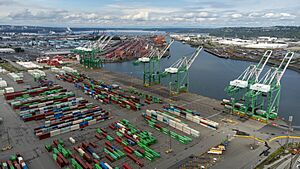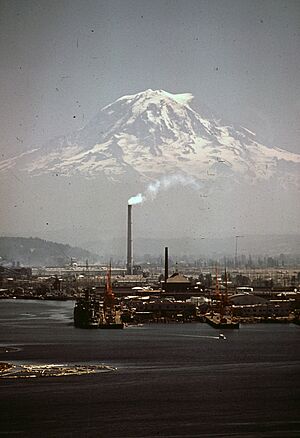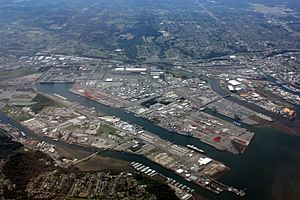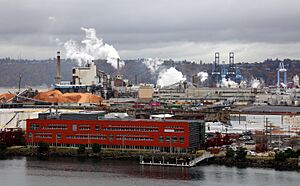Port of Tacoma facts for kids
Quick facts for kids Port of Tacoma |
|
|---|---|
 |
|
| Location | |
| Country | United States |
| Location | Tacoma, Washington |
| Coordinates | 47°15′37″N 122°24′30″W / 47.26028°N 122.40833°W |
| Details | |
| Opened | 1918 |
| Operated by | Port of Tacoma Commission |
| Draft depth | >50 feet (15.24 m) |
| Air draft | No restrictions |
| Website https://www.portoftacoma.com/ |
|
The Port of Tacoma is a busy seaport in Tacoma, Washington. People in Pierce County voted to create it on November 5, 1918. The first ship to visit the port was the Edmore in 1921. The port handles a lot of cargo, making it one of the biggest in the United States. In 2015, its cargo operations joined with the Port of Seattle to form the Northwest Seaport Alliance.
Contents
History of the Port
The Port of Tacoma started small, with about 240 acres of land. Today, it owns over 2,400 acres (about 972 hectares). This land is used for shipping, storing goods, distributing them, and making products.
Early Shipping in Tacoma
Before the Port of Tacoma was officially created, ships used to dock along Ruston Way. They also used the mouth of the Thea Foss Waterway. This waterway opens into Commencement Bay and the larger Puget Sound. Tacoma became important for shipping as early as 1853. That year, the first load of lumber was sent to San Francisco.
Tacoma's role as a major trading spot grew much stronger in 1873. The Northern Pacific Railroad decided to end its railway line here. Tacoma was chosen over other cities like Seattle for good reasons. Commencement Bay could hold more than 50 ships at once. The water was deep enough for any size ship. Plus, there was lots of waterfront land to build more port facilities.
Working with the Puyallup Tribe
The Puyallup Indian Tribe has a long history with the land where the port is located. In the 1980s, there was a disagreement about who owned some land. This land used to be part of the Puyallup River. The Puyallup Tribe won their case in court.
Later, in 1989, a special agreement was made. The Puyallup Tribe agreed to give up their remaining land claims at the Port of Tacoma. In return, they received money and other benefits. This agreement helped both the Tribe and the Port move forward.
Forming the Northwest Seaport Alliance
On October 7, 2014, the Port of Seattle and the Port of Tacoma made a big announcement. They decided to work together. They would market and run their shipping terminals as one team. This was not a full merger, but a partnership.
This joint operation began on August 4, 2015, creating the Northwest Seaport Alliance. This alliance became the third-largest cargo gateway in the United States. By the end of that year, the two ports handled over 3.5 million containers. This was a 4 percent increase from before.
How the Port Works
The Port of Tacoma plays a huge role in international trade for the Pacific Northwest. It is a public organization that follows state laws.
Each year, the port handles between 9 and 13 million tons of cargo. This cargo is worth more than $25 billion. Major items brought in (imports) include cars, electronics, and toys. Major items sent out (exports) include grain, wood products, and farm goods. The port's biggest export by weight is grain, like corn and soybeans. These come to the port by train from the Midwest.
In 2010, the port's top trading partner was China and Hong Kong. They were the biggest partners for both imported goods and their value. Japan was the top partner for exported goods and their value. The most valuable goods exported were cereals and grains. The most valuable goods imported were vehicles and their parts. Industrial machines and electronics were also important imports.
The Port of Tacoma is one of the top ten largest container ports in North America. Containers are big metal boxes that hold all kinds of things. They can carry computers, lawn furniture, apples, or frozen meat. China is the port's largest trading partner for containers.
More than 70 percent of the containers imported through the port travel by train. They go to markets in the Midwest and on the East Coast. The port uses trains from the BNSF Railway and Union Pacific railroads. Local train service is provided by Tacoma Rail. This company is owned by the City of Tacoma.
U.S. Oil and Refining has an oil refinery at the Port of Tacoma. Oil tankers bring crude oil here. The refinery turns this oil into different products. One product is JP-8 jet fuel for McChord Field Air Force base. A special pipeline connects the refinery to the airbase.
Protecting the Environment

The port area is part of a large federal cleanup site. This site is called the Commencement Bay Nearshore/Tideflats Site. The Port of Tacoma works with the United States Environmental Protection Agency (EPA). They also work with the Washington State Department of Ecology. Together, they are cleaning up different areas within this site.
Cool Facts About the Port
- The port helps create over 43,000 jobs in Pierce County. It supports 113,000 jobs across Washington state.
- Washington state has more than 70 public ports.
- The Port of Tacoma is sometimes called the "Gateway to Alaska." It handles over 70 percent of all goods shipped by water from the Lower 48 states to Alaska.
- Over the last 20 years, the port has spent more than $160 million. This money went to projects that improve the environment around Commencement Bay.



